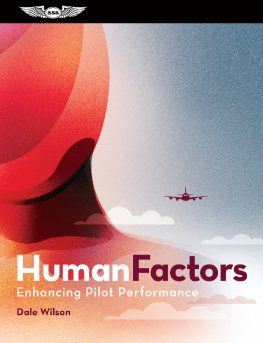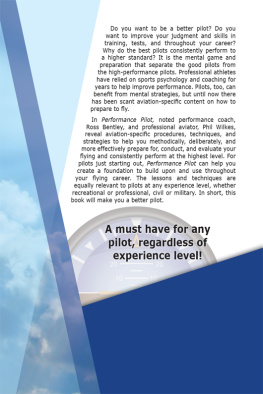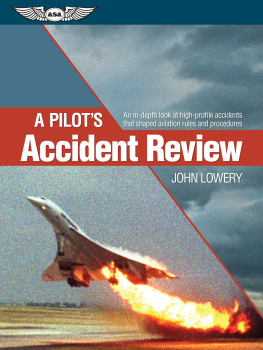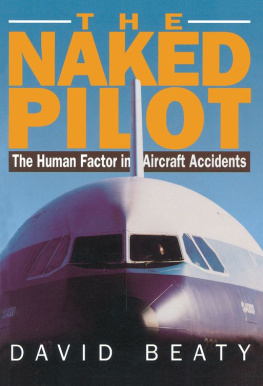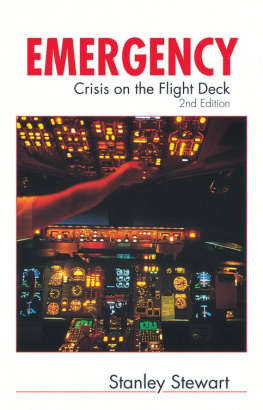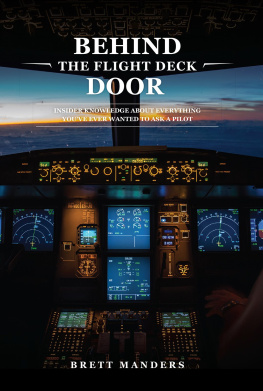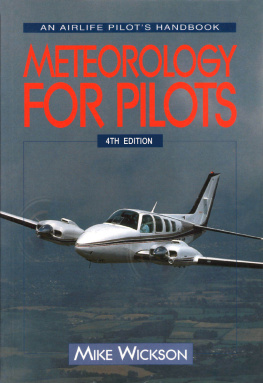
Is flying safe?
The Aviation Safety Record
A friend of mine, who lived near Vancouver, Canada, often went on winter vacations to Disneyland in Southern California with his family during his childrens Christmas break. If you thought he would choose to enjoy the three-hour journey southbound in the comfort of a modern Boeing passenger jetliner, you would be mistaken. Instead, he loaded up the minivan with his family and belongings and drove over 20 hours and more than 1,300 hundred miles at a time of year when winter road conditions could quickly become treacherous. Why did he do this? Because, according to him, it was safer than flying. What he didnt know was that, statistically, he and his family were at least 100 times more likely to die on the trip because he refused to go by air.
Before we thoroughly explore the main focus of this bookhuman factors and what they are in the aviation environmentit is important to first understand the safety context out of which the discipline arises. The first chapter of this book, therefore, compares the aviation safety record to other modes of transportation and between sectors within aviation, provides a brief overview of the various types of aircraft accidents that occur, and highlights some of the major causes of aircraft accidents.
Transportation Safety
The answer to the question in this chapters title, Is flying safe? depends on how you define safe. Flight safety is defined differently by different people, as evidenced, for example, by our Disneyland traveler. If he defines it as the total absence of danger, then his assessment would be correct: flying is not safe. However, he, along with all of us, surely realizes that practically every human endeavor, let alone activities involving movement on the earths surfaceor above itinvolves some degree of risk. For example, in the first decade of this millennium (2000 through 2009 inclusive), an average of 43,239 people died each year in transportation accidents (e.g., bicycles, cars, trucks, motorcycles, buses, aircraft, trains) in the United States making the annual risk of dying in a transportation accident about 1 in 6,800 per U.S. resident. In fact, transportation accidents are the number one cause (at almost 40 percent) of accidental deaths (often termed unintended injurydeaths) in the United States, which is the equivalent to the number of people killed by falls and poisonings, the next two highest causes of accidental deaths.1
Compared to non-highway transportation modes (aviation, rail, maritime, etc.), road methods of human transport (cars, trucks, motorcycles, buses, bicycles, etc.) claimed by far the most lives during the 10-year period accounting for 95 percent of all transportation fatalities. Conversely, U.S. aircraft accidents claimed the lives of only 646 people annually during the periodless than 0.15 percent of all transportation deathswith 85 percent of those occurring in the general aviation (GA) sector and the remaining 15 percent resulting mostly from only four scheduled air carrier (commercial airline) accidents during the entire decade.2
In fact, a look at the statistics clearly indicates that, in comparison to all other modes, commercial air-carrier flying is the safest mode of passenger transport in the United States. For example, if we compare the 0.07 passenger deaths per billion passenger-miles traveled3 on commercial flights with passenger deaths on commuter trains, ferryboats, and cars and light trucks (see Table 1-1), we see the odds of dying when traveling using these modes increase by factors of more than 6 (.43/.07 = 6.14), 45, and 104, respectively. The odds of dying while riding a motorcycle are 29 times greater than riding in a car or light truck, and an astonishing 3,000 times greater than flying on a commercial air carrier!
Table 1-1. Passenger fatalities per billion passenger-miles for selected modes for ten year period 20002009.4
Transportation mode | Passenger fatalities per billion passenger-miles |
Motorcycle | 212.57 |
Car or light truck | 7.28 |
Local ferryboat | 3.17 |
Commuter rail and Amtrak | 0.43 |
Urban mass transit rail (20022009) | 0.24 |
Bus holding more than 10 passengerstransit, inter-city, school, charter. | 0.11 |
Commercial aviation | 0.07 |
The good news for all U.S. travelers is that accidents and accident fatality rates for most modes of transportationincluding aviationhave gradually trended downward over the past several decades. For example, highway fatalities per 100 million vehicle miles dropped from 3.35 in 1975 to 1.11 by 2010, a 300 percent improvement.5 For large truck accident fatalities, the improvement was even better: fatalities per 100 million vehicle miles dropped from 5.51 in 1975 to 1.26 by 2008, more than a four-fold improvement. Other modes, such as railroad and maritime (both commercial vessels and recreational boating) have also seen significant fatality rate reductions over the years. But the fact still remains that the most dangerous part of the flight in a commercial air carrier is the drive to the airport, especially if you are on a motorcycle!
Aviation Operations
As noted, most U.S. aircraft accident fatalities (about 85 percent) during the ten-year period involved GA aircraft. Civil aviation is generally divided into two major groups: air carriers and GA.
U.S. air carriers are commercial operators certificated under Parts 121 and 135 of Title 14 of the Code of Federal Regulations (14 CFR) to carry passengers or cargo for hire. In 2018 the U.S. air carrier fleet consisted of almost 7,500 airplanes (mostly turbofan-powered) used by mainline and regional passenger air carriers and cargo carriers, to transport passengers and cargo.6 U.S. commercial carriers conducted more than nine million domestic and international flights, flew more than 17 million flight hours, carried a record 849 million passengers (called enplanements) and delivered more than 18 million tons of cargo in 2017. The U.S. commercial aviation industry directly employs more than 700,000 people and is responsible for creating over 10 million jobs (7.3 percent of U.S. jobs) and more than 5 percent of the gross domestic product in the United States.7, 8, 9
General aviation, or gen av as some call it, comprises all civilian flight operations other than scheduled commercial air carrier passenger and cargo service. With approximately 210,000 aircraft (more than 416,000 worldwide), GA accounts for more than 90 percent of the U.S. civil aircraft fleet and includes piston- and turbine-powered, single- and multi-engine airplanes (almost 80 percent of the GA fleet) and rotorcraft (e.g., helicopters), balloons, airships, and gliders. As you can imagine, GA does just about every type of flying there is, some of which includes: personal/recreational flights in piston-powered single-engine airplanes; instructional training flights (most U.S. commercial airline pilots learned to fly in GA); business and corporate transport in light, medium, or even heavy twin-engine jets; on-demand charter (air taxi) flights in piston- or turbine-powered airplanes; helicopter emergency medical (air ambulance) service; sight-seeing flights; and a variety of aerial observation/application flights, including highway traffic reporting, mapping, patrol, surveillance, search-and-rescue, crop production, and fire suppression. GA aircraft fly into more than 5,000 U.S. public-use airports (scheduled airlines fly to less than 400 U.S. airports), log more than 24 million hours per yearwith about 65 percent conducted for business and public servicesand transport an estimated 166 million passengers annually. The U.S. GA industry supports $219 billion of economic output and 1.1 million jobs. Of the almost 600,000 certified pilots in the United States, about 500,000 fly GA aircraft.10, 11, 12
Next page
